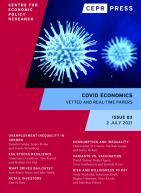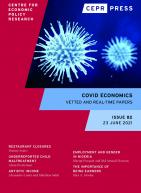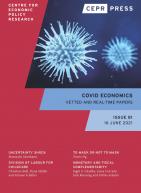
COVID-19 became a global health emergency when it threatened the catastrophic collapse of health systems as demand for health goods and services and their relative prices surged. Governments responded with lockdowns and increases in transfers. Empirical evidence shows that lockdowns and healthcare saturation contribute to explain the cross-country variation in GDP drops even after controlling for COVID-19 cases and mortality. We explain this output-pandemia tradeoff as resulting from a shock to subsistence health demand that is larger at higher capital utilization in a model with entrepreneurs and workers. The health system moves closer to saturation as the gap between supply and subsistence narrows, which worsens consumption and income inequality. An externality distorts utilization because firms do not internalize that lower utilization relaxes healthcare saturation. The optimal policy response includes lockdowns and transfers to workers. Quantitatively, strict lockdowns and large transfer hikes can be optimal and yield sizable welfare gains because they prevent a sharp rise in inequality. Welfare and output costs vary in response to small parameter changes or deviations from optimal policies. Weak lockdowns coupled with weak transfers programs are the worst alternative and yet are in line with what several emerging and least developed countries have implemented.
Citation
zhang, j, E Rojas, L Tesar and E Mendoza (2021), ‘A Macroeconomic Model of Healthcare Saturation, Inequality & the Output-Pandemia Tradeoff‘, COVID Economics 70, CEPR Press, Paris & London. https://cepr.org/publications/covid-economics-issue-70#392514_392946_391065
We estimate the factors predicting firm failures in the COVID crisis based on French data in 2020. Although the number of firms filing for bankruptcy was much below its normal level (- 36% compared to 2019) the same factors that predicted firm failures (primarily productivity and debt) in 2019 are at work in a similar way as in 2020. Hence, the selection process, although much reduced, has not been distorted in 2020. At this stage, partial hibernation rather than zombification characterises the selection into firm survival or failure. Â We also find that the sectoral heterogeneity of the turnover COVID shock (proxied by the change in credit card transactions) has been largely (but not fully) absorbed by public policy support because it predicts little of the probability of bankruptcy at the firm level. Finally, we sketch some potential scenarios for 2021-2022 for different sectors based on our empirical estimates of predictors of firm failures.
Citation
Epaulard, A, P Martin and M Cros (2021), ‘Will Schumpeter Catch Covid-19?‘, COVID Economics 70, CEPR Press, Paris & London. https://cepr.org/publications/covid-economics-issue-70#392514_392946_391066
This paper empirically examines how the opening of K-12 schools and colleges is associated with the spread of COVID-19 using county-level panel data in the United States. Using data on foot traffic and K-12 school opening plans, we analyze how an increase in visits to schools and opening schools with different teaching methods (in-person, hybrid, and remote) is related to the 2-weeks forward growth rate of confirmed COVID-19 cases. Our debiased panel data regression analysis with a set of county dummies, interactions of state and week dummies, and other controls shows that an increase in visits to both K-12 schools and colleges is associated with a subsequent increase in case growth rates. The estimates indicate that fully opening K-12 schools with in-person learning is associated with a 5 (SE = 2) percentage points increase in the growth rate of cases. We also find that the positive association of K-12 school visits or in-person school openings with case growth is stronger for counties that do not require staff to wear masks at schools. These results have a causal interpretation in a structural model with unobserved county and time confounders. Sensitivity analysis shows that the baseline results are robust to timing assumptions and alternative specifications.
Citation
Kasahara, H, P Schrimpf and V Chernozhukov (2021), ‘The Association of Opening K-12 Schools and Colleges with The Spread Of Covid-19 in The United States: County-Level Panel Data Analysis‘, COVID Economics 70, CEPR Press, Paris & London. https://cepr.org/publications/covid-economics-issue-70#392514_392946_390731
In this paper, I study a simple SIR-Macro model to examine Japan's second soft lockdown, starting in January 2021. The model's parameters are calibrated to capture both infection and economic fluctuations in 2020. I find that the government should extend this lockdown long enough to avoid another future lockdown, given the country's medical capacity. In addition, I consider the ICU targeting policy that keeps the number of severe patients at a constant level, mimicking the monetary policy's inflation targeting. These macro-level containment policies can help develop age-dependent strategies using the timing differences of vaccinations between the young and the old.
Citation
Kubota, S (2021), ‘The Macroeconomics of Covid-19 Exit Strategy: The Case of Japan‘, COVID Economics 70, CEPR Press, Paris & London. https://cepr.org/publications/covid-economics-issue-70#392514_392946_390733
How important are risk-avoidance behaviors for preventing the spread of COVID-19? Answering this question is difficult because risk-avoidance behaviors may be correlated with non-behavioral risks (such as occupational risk) and because COVID-19 prevalence is poorly measured due to limited testing. We study the prevalence of COVID-19 infections among state governors and members of the U.S. Congress. These politicians face similar occupational risks and are frequently tested. Yet we find large differences in COVID-19 prevalence along party lines: Republican politicians are three times as likely as Democratic ones to have ever reported a COVID case. The association between COVID-19 and party affiliation is not due to demographic differences, differences in state riskiness, or differential campaign strategies. Given well-documented differences in risk attitudes and preventive behavior along political lines, the differential COVID-19 rate we document is consistent with the view that behavioral risk is a key determinant of COVID-19 infections.
Citation
Wing, C, S Gupta, D Sacks and P Carlin (2021), ‘Partisan Differences in COVID-19 Prevalence Among Politicians Suggest Important Role for Protective Behaviors‘, COVID Economics 70, CEPR Press, Paris & London. https://cepr.org/publications/covid-economics-issue-70#392514_392946_390734


Covid Economics - Issue 82
- Restaurant Closures during the Pandemic: A Descriptive Analysis
- Underreporting Child Maltreatment during the Pandemic: Evidence from Colorado
- Covid-19 impact on Artistic Income
- COVID-19, Employment, and Gender: Evidence from Nigeria
- The Importance of Being Earners: Modelling the Implications of Changes to Welfare Contributions on Macroeconomic Recovery
